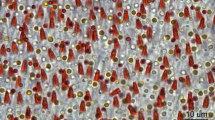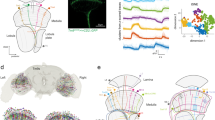Summary
The structure and synaptology of the axon of a novel photoreceptor class in the compound eye of the fly (Musca domestica) were studied with the electron microscope by means of intracellular injection of horseradish peroxidase, a rapid Golgi method, and conventional electron microscopy. The photoreceptor — a sex-specific class of R7 found only in the frontal-dorsal region of the male eye — projects directly to the lamina cartridge underlying its ommatidium, thus conforming to the neural superposition scheme. At the top of the lamina cartridge the axon makes an abrupt 90° bend sending out at least two arms that surround the bundle of monopolar cell fibres and extend to the limits of the cartridge defined by the incoming crown of R1-6 photoreceptors. This “foot terminal” ends in the most superficial layer of the lamina cartridge. The axon forms abundant synapses with so-called L2 and L3 monopolar cells, but very few, if any, with either L1 or T1. It also forms gap junctions with most or all of the other receptor axons in the cartridge including R8, which otherwise has the typical morphology of a long visual fibre.
Similar content being viewed by others
References
Boschek CB (1971) On the fine structure of the peripheral retina and lamina ganglionaris of the fly Musca domestica. Z Zellforsch 118:369–409
Braitenberg V (1967) Patterns of projection in the visual system of the fly. I. Retina-lamina projection. Exp Brain Res 3:271–298
Braitenberg V (1970) Ordnung und Orientierung der Elemente im Sehsystem der Fliege. Kybernetik 7:235–242
Braitenberg V, Hauser-Holschuh H (1972) Patterns of projection in the visual system of the fly. II. Quantitative aspects of second order neurons in relation to models of motion perception. Exp Brain Res 16:184–209
Burkhardt W, Braitenberg V (1976) Some peculiar synaptic complexes in the first visual ganglion of the fly Musca domestica. Cell Tissue Res 173:287–308
Cajal SR, Sanchez D (1915) Contribucion al conocomiento de los centros nerviosos de los insectos. Trab Lab Invest Biol Univ Madrid 13:1–168
Campos-Ortega JA, Strausfeld NJ (1972) The columnar organisation of the second synaptic region of the visual system of Musca domestica L. I. Receptor terminals in the medulla. Z Zellforsch 124:561–585
Campos-Ortega JA, Strausfeld NJ (1973) Synaptic connections of intrinsic cell and basket arborisations in the external plexiform layer of the fly's eye. Brain Res 59:119–136
Chi C, Carlson SD (1976) Close apposition of photoreceptor axons in the housefly. J Insect Physiol 22:1153–1156
Franceschini N, Hardie R (1980) In vivo recovery of dye-injected photoreceptor cells in the retina of the fly Musca domestica. J Physiol (Lon) 301:59P
Franceschini N, Hardie RC, Ribi W, Kirschfeld K (1981) Sexual dimorphism in a photoreceptor. Nature 291:241–244
Hardie RC (1979) Electrophysiological analysis of the fly retina. I. Comparative properties of R1–6 and R7 and R8. J Comp Physiol 129:19–33
Hardie RC, Franceschini N, Ribi W, Kirschfeld K (1981) Distribution and properties of sex-specific photoreceptors in the fly Musca domestica. J Comp Physiol 145:139–152
Hausen K, Strausfeld NJ (1980) Sexually dimorphic interneuron arrangements in the fly visual system. Proc Roy Soc Lond B 208:57–71
Horridge GA, Meinertzhagen IA (1970) The accuracy of the patterns of connections in the firstand second-order neurons of the visual system of Calliphora. Proc Roy Soc Lond B 175:69–82
Kirschfeld K (1967) Die Projektion der optischen Umwelt auf das Raster der Rhabdomere im Komplexauge von Musca. Exp Brain Res 3:248–270
Laughlin S (1981) Neural principles in the peripheral visual systems of invertebrates. In: Autrum H (ed) Handbook of sensory physiology Vol VII/6b. Springer, Berlin Heidelberg New York, pp 133–280
Nässl DR (1981) Transneuronal labeling with horseradish peroxidase in the visual system of the house fly. Brain Res 206:431–438
Nicol D, Meinertzhagen IA (1982) An analysis of the number and composition of the synaptic populations formed by photoreceptors of the fly. J Comp Neurol 207:29–44
Ribi WA (1976) The first optic ganglion of the bee. II. Topographical relationships of second order neurons within a cartridge and to groups of cartridges. Cell Tissue Res 171:359–373
Ribi WA (1978a) A unique hymenopteran compound eye. The retina fine structure of the digger wasp Sphex cognatus Smith (Hymenoptera, Sphecidae). Zool Jb Anat 100:299–342
Ribi WA (1978b) Gap junctions coupling photoreceptor axons in the first optic ganglion of the fly. Cell Tissue Res 195:299–308
Shaw SR (1981) Anatomy and physiology of the identified non-spiking cells in the photoreceptor-lamina complex of the compound eye of insects, especially Diptera. In: Roberts A, Bush BMH (eds) Neurones without impulses. Soc for Exp Biol Seminar series 6. Univ Press. Cambridge, pp 61–116
Shaw SR, Stowe S (1982) Freeze fracture evidence for gap junctions connecting the axon terminals of dipteran photoreceptors. J Cell Sci 53:115–141
Smola U, Meffert P (1979) The spectral sensitivity of the visual cells R7 and R8 in the eye of the blowfly Calliphora erythrocephala. J Comp Physiol 133:41–52
Strausfeld NJ (1971) The organisation of the insect visual system (light microscopy) I. Projections and arrangements of neurons in the lamina ganglionaris of Diptera. Z Zellforsch 121:377–441
Strausfeld NJ (1976) Atlas of an insect brain. Springer, Berlin Heidelberg New York
Strausfeld NJ (1980) The Golgi method: its application to the insect nervous system and the phenomenon of stochastic impregnation. In: Strausfeld NJ, Miller TA (eds) Neuroanatomical techniques. Springer, New York Heidelberg Berlin, pp 131–203
Strausfeld NJ, Campos-Ortega JA (1973) The L4 monopolar neuron: substrate for lateral interaction in the visual system of the fly Musca domestica (L.) Brain Res 59:97–117
Strausfeld NJ, Nässl DR (1981) Neuroarchitectures serving compound eyes of Crustacea and Insects. In: Autrum H (ed) Handbook of sensory physiology Vol VII/6b Springer, Berlin Heidelberg New York, pp 1–132
Trujillo-Cenoz O (1965) Some aspects of the structural organisation of the intermediate retina of Dipterans. J Ultrastruct Res 13:1–33
Wehrhahn C (1979) Sex-specific differences in the chasing behaviour of free-flying houseflies (Musca) Biol Cyb 32:239–241
Author information
Authors and Affiliations
Rights and permissions
About this article
Cite this article
Hardie, R.C. Projection and connectivity of sex-specific photoreceptors in the compound eye of the male housefly (Musca domestica). Cell Tissue Res. 233, 1–21 (1983). https://doi.org/10.1007/BF00222228
Accepted:
Issue Date:
DOI: https://doi.org/10.1007/BF00222228




